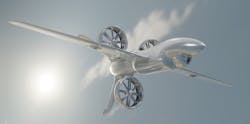Wanted: unmanned X-plane to operate from small surface warships for communications, intel, and surveillance
ARLINGTON, Va. – U.S. military researchers are asking industry to develop and demonstrate an advanced unmanned X-plane for long endurance, vertical takeoff and landing (VTOL) from small ship flight decks and austere land locations in bad weather and sparse infrastructure.
Officials of the U.S. Defense Advanced Research Projects Agency (DARPA) in Arlington, Va., issued a solicitation last week (DARPA-PS-23-03) for the AdvaNced airCraft Infrastructure-Less Launch And RecoverY (ANCILLARY) project.
The ANCILLARY program’s primary objectives are launch and recovery without infrastructure; extended endurance and range; high payload to weight ratio at a tactical scale; and robust flight controls and relative navigation.
ANCILLARY contractors will focus on three technical areas: advanced VTOL configurations; power and propulsion architecture; and controls and automation.
Related: Unmanned Aircraft Armed and dangerous
DARPA researchers expect contractors to develop a prototype unmanned X-plane initially that has a gross takeoff weight of less than 250 pounds, and eventually to have a gross takeoff weight of less than 330 pounds.
These unmanned X-planes will function as communications relays, redundant sensors, multi-intelligence , surveillance and reconnaissance aircraft. The X-lane unmanned aerial vehicle (UAV) will have a new kind of propulsion with a challenging thrust-to-weight ratio, and low fuel consumption.
It is expected that performers will explore several power and propulsion designs in initial phases that could involve hybrid electric propulsion, internal combustion engines, or small turbines that use heavy fuel. Gasoline and hydrogen-based fuels are specifically excluded.
Related: Navy demonstrates ability to launch surveillance UAVs stealthily from submerged submarines
Other technology focuses of the project will involve thrust generators, power sources, power storage and distribution, automated ship deck landings, optical-based relative navigation, advanced control effectors, and direct-to-axis flight control.
Using all-axis control will enable precise position, velocity, and pose necessary for automated shipboard recovery, DARPA researchers say. Automated launch and recover are key research areas. ANCILLARY is a three-phase program spanning four years, including conceptual design through at-sea flight demonstration. Phase 1a involves conceptual design, phase 1b is preliminary design to a preliminary design review, and phase 2a is detailed design.
Companies interested must email 10-page abstracts no later than 6 Jan. 2023 at [email protected]. Companies submitting promising abstracts may be invited to give oral proposal presentations in late February 2023. Email questions or concerns to DARPA at [email protected]. More information is online at https://sam.gov/opp/407db2a2ff594e7f9383bb01fb1c98f2/view.
About the Author
John Keller
Editor-in-Chief
John Keller is the Editor-in-Chief, Military & Aerospace Electronics Magazine--provides extensive coverage and analysis of enabling electronics and optoelectronic technologies in military, space and commercial aviation applications. John has been a member of the Military & Aerospace Electronics staff since 1989 and chief editor since 1995.
